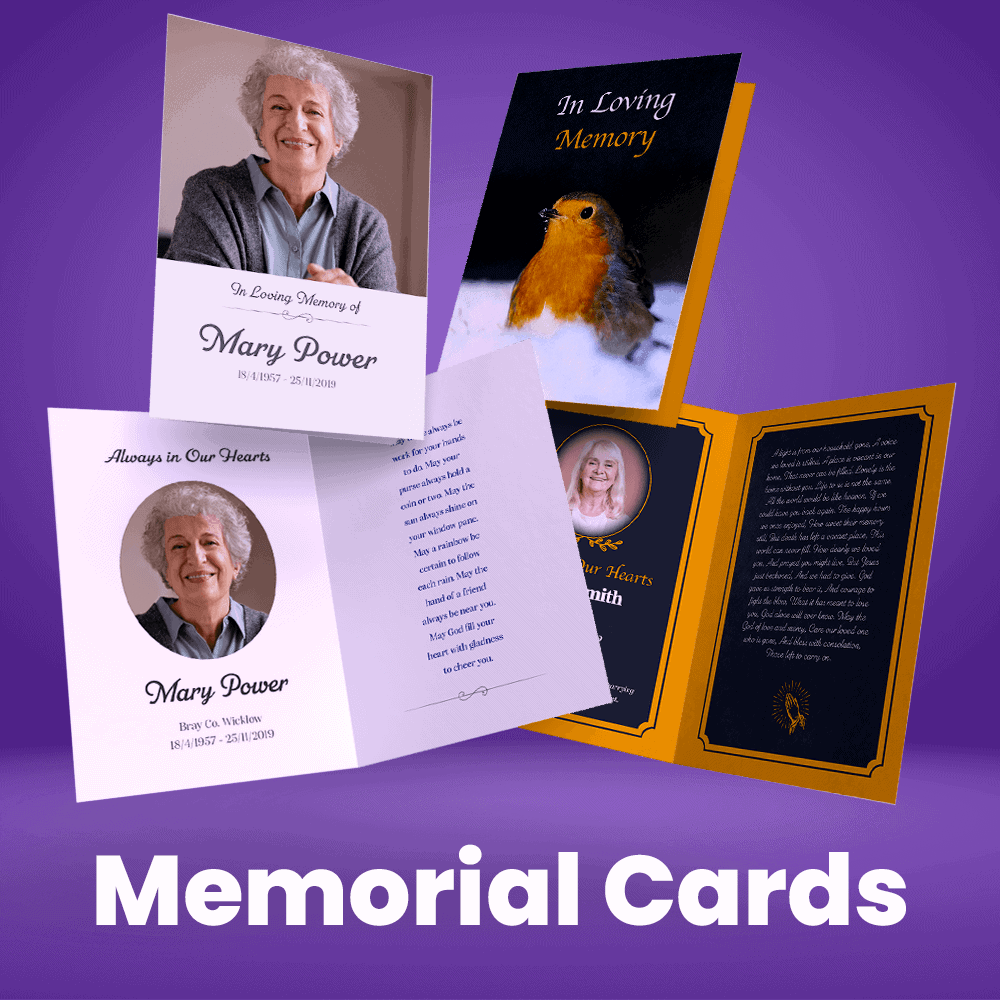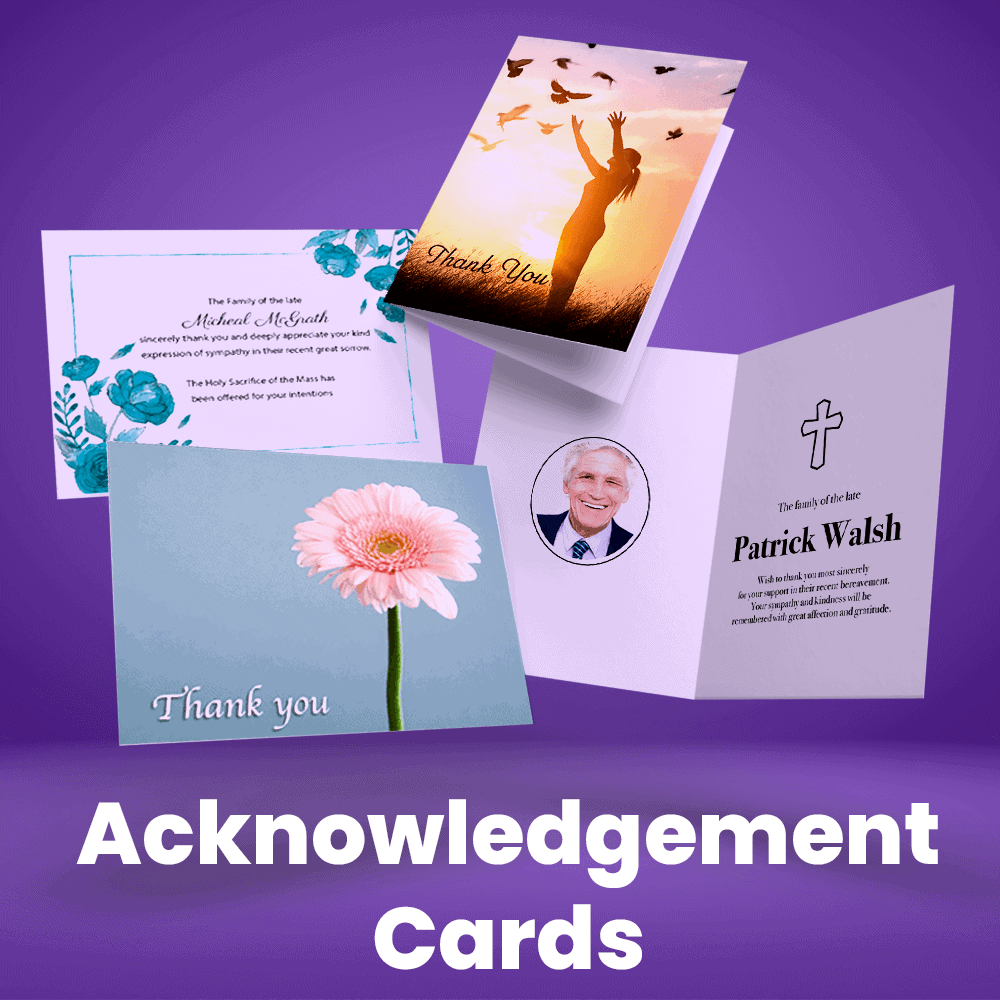Eternal Memorial Cards© since 1991
Luxury Memorial Cards | Designed & Printed In Ireland . Guidance first published Oct 14, 2014

A Memorial Card, also known as a Mortuary card or a memoriam card, is a customised card that features a photograph or a collection of photographs, along with the name and details of the deceased. It may also include a chosen poem or words selected by the family.
Some suggest sending it within a year, before the first anniversary. However, there’s no need to feel pressured to complete the cards by a specific deadline, and we have had people do them up to 5 years afterwards but generally its within the first year . People will understand, so take your time and discuss with your family what you would like to do. This task can be challenging, as it may take time to make decisions and finalize the cards.
Generally, Memorial Cards are sent to immediate family members, relatives, friends, and neighbours of the deceased also to work Colleagues and any associations or clubs that the deceased was a member of.
Gathering all the addresses for mailing the cards can be difficult. Ideally, the quickest and easiest way is to create a file in a Word and print address labels. Alternatively, you can address the envelopes by hand.
For the main picture, try to use a recent photograph if possible. It should be well-lit, focused, and the person should be clearly looking at the camera. Minor blemishes and background objects can be removed. If you’re creating a collage of photographs, include a few old and recent ones that you think might be suitable, so you have a variety to work with for the first proof.
Here are some tips to help you pick the right photo for a memorial card:
- Choose a photo that shows your loved one in a relaxed moment, like a casual snap that brings back happy memories.
- Make sure the photo is clear and sharp by using a high-resolution scan or the original digital file. Low-quality images can look fuzzy or pixelated when printed.
- Old printed photos often have a unique charm that looks great in a collage showing different stages of someone’s life.
- Take a clear photo of a printed picture using a good phone camera. Place the photo on a well-lit surface, like a kitchen counter, and take the picture from directly above to avoid shadows.
- Use photos taken in natural light for the best clarity and colours. Avoid dimly lit photos or ones that are blurry, as they won’t print well on the memorial card.
- Pick photos with simple backgrounds to keep the focus on the person. If needed, we can use software like Photoshop to blur or blend backgrounds.
- We can improve photos with professional editing software to adjust brightness, contrast, and colours for better quality.
- Provide the original, un cropped version of the photo if possible. This helps us frame the picture nicely on the memorial card.
- Black and white photos can look timeless and elegant. If the original colour photo isn’t great, converting it to black and white can be a good option.
- Get feedback from family or friends when choosing a photo. They might have insights that help you make the best decision.
- We have our own in house Graphic Designer who is an expert in photoshop so we have been known to work miracles with photos
- We will not charge you within reason for photo restoration
- A good photo is worth 1000 words
- We can combine photos to make a collage for your Memorial Cards,Wallet Card,Bookmark,Acknowledgment Card,Lifetime Card or Unique Memorial Card Range
If you’re unsure about a photo, you can send it to us at info@eternalmemorialcards.ie , and we’ll give you expert advice.
If you have any inquiries, please don't hesitate to contact us at info@eternalmemorialcards.ie
If you have any inquiries, please don't hesitate to contact us at info@eternalmemorialcards.ie
GUIDELINES FOR SENDING FUNERAL THANK YOU CARDS / ACKNOWLEDGEMENT CARDS

After the loss of a loved one, people may receive floral arrangements, mass cards, and sympathy cards. Many mourners may have travelled long distances to show their support during the funeral. Others may have made sandwiches brought gifts , made tea, organised parking or assisted after the bereavement in any way . Some may wonder if all these people should be acknowledged with a Thank You Card / Acknowledgement Card. While it is recommended to acknowledge a floral arrangement or mass card with a card, it is not necessary to reply to every Sympathy Card received. Sometimes, the sheer volume of cards makes this task very difficult.
However, recognizing all the thoughtful, loving, kind, and supportive people can help the bereaved realize they are not alone. Writing out these greeting cards may bring up thoughts and memories of the loved one they lost, aiding in the grieving process. Reading messages and stories from family, friends, neighbours and acquaintances can be very comforting and assist with the healing process.
A Thank You Card / Acknowledgement Card is the family’s way of expressing gratitude to everyone who provided help and support before, during, and after the funeral. They can be sent to a wider circle of friends, acquaintances, or anyone who offered assistance. For example, neighbors, community members, medical professionals, nurses, carers, specific hospital wards, associations, charities you wish to acknowledge, the celebrant, musicians, and those who participated in the Mass, service, or celebration of life, as well as the funeral directors.Any mourners who may have travelled long distances to show their support during the funeral. Others may have made sandwiches brought gifts , made tea, organised parking or assisted after the bereavement in any way
When composing Thank You Cards / Acknowledgement Cards, you may want to include a personal thought or two about your deceased loved one that is appropriate for the recipient. Alternatively, you can keep your note simple by saying, “Thank you for your expression of kindness.” The message you include should depend on your relationship with the recipient. For co-workers or clients, a brief message might suffice, while for family and close friends, a more meaningful message would be appropriate.
- We would like to thank you for sharing your memories, support, and love.
- On behalf of everyone here, we extend our heartfelt appreciation for the beautiful memories, unwavering support, and boundless love you have shared with us…
- We are deeply grateful for the numerous acts of kindness that you have bestowed upon us. Your generosity will forever hold a special place in our hearts.
- We hereby acknowledge and sincerely appreciate your kind and considerate expression of sympathy, tenderly received and acknowledged by.
- In this time of profound sorrow, we would like to convey our deepest gratitude for your friendship, benevolence, and prayers. The value of friends and family becomes even more evident during moments of loss. Your thoughtfulness has brought us great solace.
- Your sympathetic words and gestures are truly cherished, and we cannot adequately express our gratitude. It is the support of our loved ones that has carried us through these challenging times. Thank you for your unwavering support and empathy.
